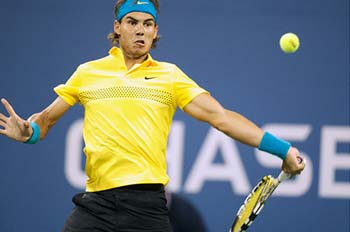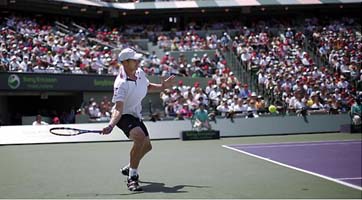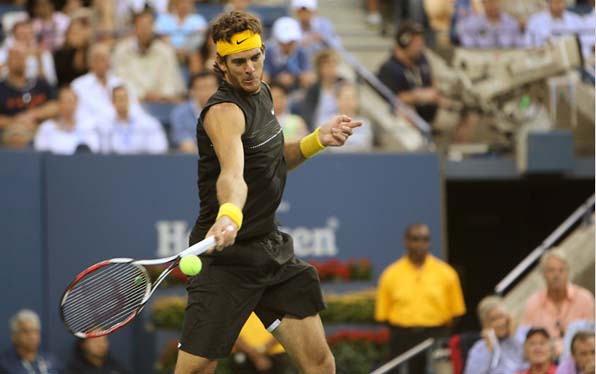
By Jim McLennan
(September 21, 2010) Rafael Nadal, Roger Federer, Novak Djokovic – their forehands, aka the modern forehand, they look totally different from the ones we were taught in (tennis) school many years ago. Books on tennis from the 50’s 60’s and 70’s showed a full and deliberate backswing, and a long (or perhaps tortuous) forward swing with the racquet finishing out in front and pointing to the target. Not all were taught this way, but interestingly the evolution of our game has occurred on two levels – first with the players who have explored various methods and have led by example, and then secondly by the teachers who are sometimes a few years behind the players but finally come to understand and are able to teach others the modern variations on technique.
Back Fence Front Fence is now Front Fence Back Fence
“Back in the day” players were taught early and deliberate preparation, a shift of weight, and a long follow through. The oft heard phrase from that era was (and it still rattles around the courts) “Racquet back, get the racquet back early!” The racquets were heavier then (I still have a 14 ounce Jack Kramer in one of my old tennis bags) and the sweet spots considerably smaller, and this may have been the main contributor to that particular style of play. And I remember sort of a blocking feeling from those days, where I (and others) came against the ball wanting a firm collision rather than a whipping racquet head. Yes John Newcombe and Tom Okker used whipping forehand strokes but they were rare and not the norm.
In the modern, racquet speed model, it appears the professionals do the exact opposite. Their initial preparation involves a turn to the side but they deliberately delay taking back of the racquet. Said another way, in the old days it was prepare by pointing the racquet to the back fence, and finish with the racquet pointing to the front fence. Now the reverse is true, players prepare with the racquet pointing to the front fence and finish with the racquet pointing to the back fence. Reasons are many – perhaps the game simply evolved, the racquets are certainly lighter, the players seem stronger and better trained, and for better or worse the game is now about violent topspin more than methodical placement.
Fed turns to the side, the ball is about to be hit, and still the racquet is not truly back
Fed finishes with the racquet pointing to the back (not the front) fence

Short Powerful Quick Swings – all about the Lag
On the forward swing (said again, the forward swing and not the backswing) the hand pulls on the handle, but the racquet head actually delays, lagging behind, then catches up in a whipping motion at impact. Note the lagging racquet head picks up speed at impact, with a short yet somehow loose motion. Not a big backswing, not an enormous follow through, but serious racquet head speed at impact.
Perhaps a good example is a group of children playing crack the whip on an ice rink or frozen pond. When done to its best effect (depends on how you define this for the effect on the first kid is far different than the effect on the last kid) the largest and heaviest child is at the center and pulling first, and in a string of 5 children along this line each child is progressively smaller, with the smallest and lightest one at the end. And this whip cracking starts slowly, but builds speed through each successive child/link, until the last child is hurled much faster than anyone might expect.
The same is true of the forehand. The legs and hips are first and they pull the torso, which in turn pulls the shoulder, which in turn pulls the arm, which in turn pulls the hand, which in turn and finally pulls on the racquet. And just as a chain of three children creates less force than a chain of five children, the same is true of the forehand. More links, each one lagging ever so slightly, and the racquet achieves speeds unknown in a previous era.
Takeaways to feel and then master the lag
-Loosen up
-Loosen your grip and loosen your arm
-Use your legs and hips as much as possible – power comes from the ground up
-Experiment with low eastern or semi western forehand grips – to hit the ball more in front
-Take your time on this – were it easy everyone would have one of these strokes
Examine the photos below of Rafa and Andy and Delpo (but they could be just as easily about nearly any of the modern group) and you can clearly see how the racquet head is lagging until what appears to be the absolute last moment.
Nadal lagging the racquet head just before contact

Roddick lagging racquet head just before contact

Del Potro lagging at the last possible moment

Jim McLennan is the Editor of TennisOne and publisher of Essential Tennis Instruction, and insightful and cutting edge blog on tennis. He is the Tennis Director at the Fremont Hills Country Club in Los Altos Hills, California, he holds a masters degree in Sports Psychology, is a past president of the USPTA’s NorCal division, and has been a lifelong player teacher and student of the game of tennis
Get free tennis lessons from Jim for a bigger and better serve here.